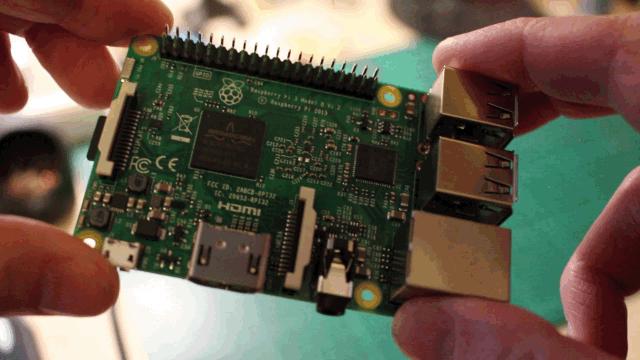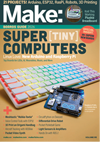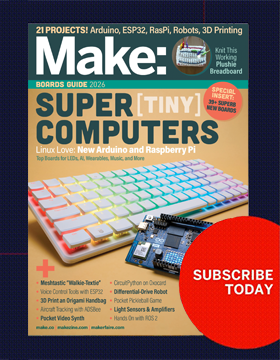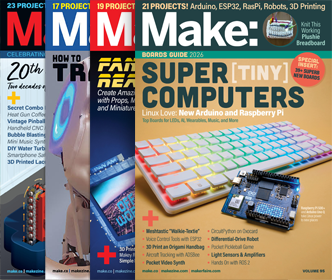
Today is the Raspberry Pi’s fourth birthday, and along with birthday wishes, we’re welcoming their newest board. Almost exactly a year after the arrival of the Raspberry Pi 2, say hello to the new Raspberry Pi 3, Model B. The new board is the first 64-bit Raspberry Pi, and comes with built-in Wi-Fi and Bluetooth.

The Specs
- Quad-core 64-bit ARM Cortex A53 clocked at 1.2 GHz
- Roughly 50% faster than Raspberry Pi 2
- 802.11n Wireless LAN
- Bluetooth 4.1 (including Bluetooth Low Energy)
- 400MHz VideoCore IV multimedia
- 1GB LPDDR2-900 SDRAM (i.e. 900MHz)
- Priced at $35
(Find the board that is right for your project in the interactive Make: Board Guide)
Intended not just as a desktop replacement, but also to be used in embedded projects, the Pi 3 has been deliberately designed as an evolution rather than a revolution for the Raspberry Pi platform. Which makes a lot of sense.

With over 8 million Raspberry Pi boards now sold, keeping backwards compatibility is important to the Foundation. That’s a lot of users and teaching materials. In fact, backwards compatibility was one of the things that Eben Upton, the founder of Raspberry Pi, emphasised when we sat down and talked to him about the new board in the run up to today’s launch, and it’s the driver behind many of the design decisions for the board.
The new Pi is fast
On the surface, the new board looks almost exactly the same as its predecessor. But while it keeps the same $35 price tag, a lot has changed under the surface. Dropping the ARM v7 architecture of the Raspberry Pi 2, this is the first 64-bit Raspberry Pi, with a quad-core 64-bit ARM Cortex A53 clocked at 1.2GHz.
| Board | Dhrystone (MIPS) | Whetstone (MWIPS) | Sysbench CPU (sec) | |
|---|---|---|---|---|
| Model B+ | 847.11 | 232.558 | 510.81 | |
| Model A+ | 863.17 | 236.858 | 502.42 | |
| Zero | 1237.29 | 340.498 | 349.43 | |
| Pi 2 | Single-threaded | 1671.58 | 437.212 | 293.08 |
| Multi-threaded | 76.28 | |||
| Pi 3 | Single-threaded | 2458.1 | 711.363 | 182.225 |
| Multi-threaded | 49.02 | |||
| Benchmarking results for the Raspberry Pi boards. Credit: The MagPi Magazine. | ||||
That makes the new BCM2837 more than 50% faster than the Raspberry Pi 2, and almost ten times faster than the original Model B. Although that performance does come at a cost, the new Raspberry Pi 3 draws half-again more power than the old Raspberry Pi 2.
| Model B+ | Model A+ | Zero | Pi 2 | Pi 3 | |
|---|---|---|---|---|---|
| Idle (Amps) | 0.25 | 0.11 | 0.1 | 0.26 | 0.31 |
| Loaded (Amps) | 0.31 | 0.17 | 0.25 | 0.42 | 0.58 |
| Power draw results for the Raspberry Pi boards. Credit: The MagPi Magazine. | |||||
However the Raspberry Pi 3 seems to have crossed a performance threshold. Despite not increasing the 1GB of on-board RAM provided by the Raspberry Pi 2, the new board seems to have become “good enough” to replace a desktop PC for most people, most of the time.

The BCM2837 powering the new board is a direct evolution from the BCM2836 used for the Raspberry Pi 2, and the BCM2835 used on the original board and the Raspberry Pi Zero.
“Although it is a 64‐bit core, we’re using it as just a faster 32‐bit core” — Eben Upton
Backwards compatibility between the boards is seen as vital by the Foundation.
The new Pi is connected
Perhaps the biggest change is that the new Raspberry Pi 3 comes with both built-in Wi-Fi and Bluetooth 4.1. That means that the new board will support Bluetooth “Classic” and, somewhat more usefully, Bluetooth LE. Which makes the new Raspberry Pi not just a desktop replacement, but a perfect hub for the emerging Internet of Things.
While you could always add Wi-Fi and Bluetooth USB dongles to the Raspberry Pi, building the hardware into the board simplifies everything. Previously, it would cost another $20 on top of the price of the Raspberry Pi to add third-party Wi-Fi and Bluetooth LE USB adaptors; bringing the radio onboard eliminates that cost, and also gets rid of incompatible hardware and driver issues.
Almost inevitably, news of the new Raspberry Pi 3 was leaked ahead of time, rumors started to appear almost two weeks ahead of today’s official launch. But like many modern technical products it was the unavoidable FCC filing for the board that gave the game away, although I’m not sure the Foundation will forgive CPC for letting people actually order the board ahead of the launch all that quickly.
We’ve been hands on with the new Raspberry Pi board here at Make: for a couple of weeks, and we’ve found the new board to be really stable, and fast. That said, while we’ve been testing, the board support for Wi-Fi and Bluetooth were still being worked on fairly heavily by the Foundation, and support for the onboard Bluetooth hardware still won’t be available on launch day — although it should be available soon afterward.
We also ran into one problem with the onboard Wi-Fi that only occurred whilst running the new board in headless mode. This ended up being caused by a power-saving mode on the connectivity chip. Effectively the board became unresponsive in headless mode if it was connected to the network only via Wi-Fi.
“We’ll be shipping a patch at some point to give people the option to disable the power saving.” — Eben Upton
In the meantime, if you’re running the board headless remember to enable keep-alive in your ssh client or you’ll run into a similar problems.
Looking at the hardware
Apart from the position of the LEDs, and the new radio chip and antenna — located between the display connector and the GPIO headers — the new board looks very similar to the Raspberry Pi 2. However there are a few interesting things to make note of about the new hardware that might not be immediately obvious from an initial inspection.


Many manufacturers use a pre-built ‘module’ to add a wireless capability, which means they can rely on the certification of the module to get their board to market. However the new Raspberry Pi’s wireless radio chip is soldered directly onto the board. While this means that the new board had to be FCC certified, a big upfront cost, it’s a lot cheaper in the long run and simplifies production if you build enough boards. We figure that there will be enough Raspberry Pi 3 boards produced that the Foundation made the sensible choice here.
The camera-shy Raspberry Pi 2 suffered problems with the switched mode power supply (SMPS) chip on the board, which turned out to be photosensitive. Too much light, such as from flash photography, caused fluctuation in the power supply and made the board reset. Looking at the shiny BCM43438 radio chip, it also lacks any encapsulation, so it’s possible that there may be a similar sort of problem. However, it’s noticeable that the SMPS chip on the new board is safely encapsulated.

The other interesting thing on the back of the board, right next to the wireless radio chip, is something that looks like an unpopulated UFL antenna, labelled J13 on the silk screen. You can just seen the board’s antenna in the image above on the flip side of the board directly below the unpopulated contacts.

While we’re not going to get any support from the Foundation — it would break the terms of their FCC certification to document it — I’m looking forward to the first hack to add a cantenna to the Raspberry Pi either by desoldering the on-board antenna, or making use of those unpopulated pads on the back of the board. Cheap long range Wi-Fi is just a Pringle’s can away.
Interestingly the BCM43438 that the new Raspberry Pi 3 uses to provide Wi-Fi and Bluetooth also has an FM receiver. Whether that’s been disconnected in hardware, or just unsupported in software, is something I’m really interested in finding out. Building an FM radio from a Raspberry Pi may suddenly have gotten a lot easier.
In closing
I think there will, inevitably, be a lot of complaints about the direction that the Raspberry Pi Foundation has taken with the new board. People will complain that the Foundation has failed to increase the memory on the board from 1GB. There will be complaints that the onboard Ethernet is still tied to the USB controller, or that the new Wi-Fi is only single band. To these people I’ll point out that backwards compatibility matters a lot more to the Foundation than it does to you.
With 8 million boards in circulation, and a mission to further education, the Foundation really cares that the code and binary blobs that ran on the original Raspberry Pi still runs, four years later, on the new Raspberry Pi 3. The educational mission behind the Raspberry Pi is often overlooked by the maker community, but it is the driver behind the release of this board.
In the run up to today’s launch we sat down and talked with Eben Upton, the founder of Raspberry Pi, about the board, and the huge community that has grown up around it over the last four years.
The new board is available today, and costs $35.
ADVERTISEMENT










